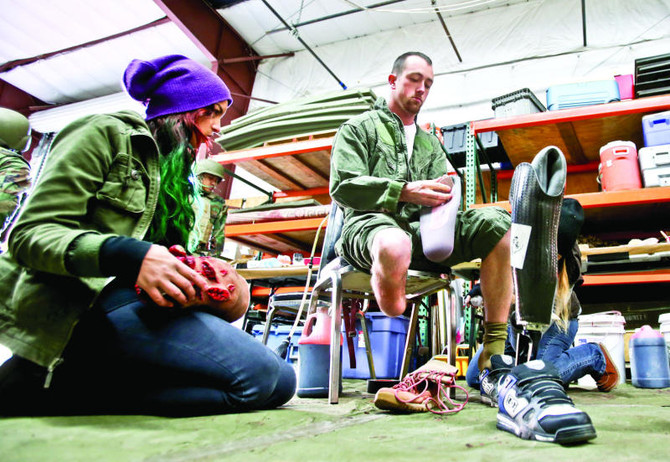The US sailor had been back from war for just over a year when friends invited him to watch an unusually emotional training exercise for troops preparing to deploy.
The drill happened not on a military base but at a film studio, where Marine and Navy medics role-played wartime rescue missions with actors who had, in real-life, lost limbs in motorcycle or car accidents or to ailments such as cancer.
Those on hand weren’t sure how Joel Booth would react. The 24-year-old had been attached to a Marine battalion in Afghanistan as a naval combat medic — until he stepped on an explosive and doctors, two years ago, amputated his right leg below the knee. Since returning home he’d had to learn to adapt while also coping with the post-traumatic stress.
But Booth was transfixed as fake bombs exploded and medics practiced the type of rescue missions he’d once been on, saving the amputee actors — as he, in the end, had to be saved.
Then the young veteran did something unexpected: He asked for an audition.
Perhaps, he thought, this injury that had forever altered his life could help save someone else’s. What he didn’t know was how much reliving the horrors of war would help him, too.
“In society, amputees are seen by people on a large scale as having a disability, being weaker. But ... even someone who doesn’t have a hand can still operate a weapon to be able to defend themselves,” he said.
“It’s the same thing for me. I’m not afraid of it just because something bad happened. For people who haven’t been in combat, it’s hard to understand.”
Producer Stu Segall, best known for the TV police show “Silk Stalkings,” started Strategic Operations in 2002 shortly after the launch of the Iraq war to offer the military what it calls “hyper-realistic” training by using movie-making special effects and actors.
The group has since trained hundreds of thousands of troops in recreated scenes from Iraq, Afghanistan, Somalia and other hotspots. The creators strive to make the re-enactments as jarring as possible so troops experience war first in a controlled environment, and learn not to be rattled by it.
Marine 2nd Lt. Duane Blank, a commander who has gone through similar training, said amputee actors add a degree of realism that no one else can.
“The visual effect is invaluable because it’s something you don’t encounter every day,” said Blank, an Iraq war veteran. “There is no way to recreate that aspect of real combat, seeing a brother hurt in that sort of way.”
Since the inception of Strategic Operations, the group’s founders had made a concerted effort not to use veterans who lost limbs in combat.
“We felt it was one of those things: Why would you ask somebody who has gone through this experience to relive it? And we had plenty of amputee actors,” said executive vice president Kit Lavell.
Lavell flew 243 missions in Vietnam as a naval aviator. He knows how hearing screams and explosions — even on a studio lot in San Diego — can quickly bring back the stress of battle for even the most hardened soldiers.
But Booth convinced Lavell to let him join the group.
“He was so well-prepared as a corpsman,” Lavell said. “We felt: He’s the perfect one to do this.”
Booth first joined the Navy, at the age of 21, because he wanted to see combat and help save lives. The job of corpsman was perfect for him; as field medics in charge of providing emergency care to battleground troops, corpsmen often are caught in the thick of the action.
Almost a year after enlisting, he was deployed with the Marines to the Taleban stronghold of Sangin, Afghanistan. On July 21, 2011, while out on patrol, he and a Marine volunteered to return to base to get supplies. As they were walking, an explosion catapulted Booth onto his back.
He calmly told the Marine to check behind them for more improvised explosive devices. Then he looked down at his leg. There was no blood but the pain was excruciating and Booth couldn’t stand up. His ankle bones had been crushed.
Two days later he was back in the US, where he underwent surgery after surgery. But Booth didn’t want to be a patient. Frustrated with each failed operation and a growing infection, he pushed his doctors to amputate.
As a medic, Booth knew what his life would be like without a limb, and he wasn’t afraid. He had seen fellow service members adapt relatively quickly to using a prosthetic. He figured he could return quickly to an active lifestyle, doing the things he enjoyed, like riding motorcycles.
Booth learned his tenacity from his dad, a Black Hawk helicopter pilot in the Gulf War who taught his son to remember when faced with a challenge: “It could be worse. Just get through it and get on with it.”
On Nov. 29, 2011, doctors amputated Booth’s lower right leg. He was fitted with his prosthesis, and began therapy three times a week to learn how to walk again.
But Booth soon noticed his injuries went beyond the physical. During the day, he felt on edge. At night, he had nightmares or insomnia. He started seeing a psychiatrist, who diagnosed him with post-traumatic stress disorder and prescribed medication.
He wondered what he would do with his life when some Navy instructors who were training young medics invited him to the film studio.
A year ago in April, Booth started work with Strategic Operations. He has now performed with the group a dozen times, and he isn’t bothered by the gore and gunfire. Rather, said Booth, the exercises have helped him deal with his post-traumatic stress.
“When we’re at the point where the explosions and the gunfire is going off, I’m in a whole different mindset. I’m yelling and screaming and waiting for the corpsmen to come help me. So I’m not really worried about that (PTSD) anymore,” said Booth, who has since stopped taking his PTSD medication. “It’s more so about the guys coming to get me and really helping them.”
Mental health professionals said they are not surprised Booth has found solace in his role-playing.
Amputee veteran helps train US troops
Amputee veteran helps train US troops

Kodi, star of ‘Dog on Trial,’ takes home Cannes’ top dog prize

- The Griffon mix was praised for his “breathtaking” performance as Cosmos, a guide dog for a visually impaired man
- Xin, the greyhound who made a star turn in Chinese director Guan Hu’s “Black Dog,” was awarded the Palm Dog’s Grand Jury Prize
CANNES, France: There was lots of tail-wagging and face-licking as Kodi, this year’s winner of the Palm Dog, the canine equivalent of the Cannes Film Festival’s top prize, went up to receive his red collar for the French comedy “Dog on Trial” on Friday.
The Griffon mix was praised for his “breathtaking” performance as Cosmos, a guide dog for a visually impaired man, who goes on trial over an attack, in a case whose outcome could mean death.
“This film is very significant because it not only explores the bond between humans and dogs but it takes a satirical, comedic but quite profound look at the way that we domesticate dogs and the way that we relate to dogs, and the way our justice system relates to dogs,” said critic and jury member Anna Smith.
Xin, the greyhound who made a star turn in Chinese director Guan Hu’s “Black Dog,” was awarded the Palm Dog’s Grand Jury Prize.
Xin was in Cannes to don the red collar for the film about an ex-convict tasked with ridding his town of stray dogs who befriends one of them.
The unofficial awards show, which was created in 2001, is now in its 24th edition.
Kodi succeeds last year’s winner, Messi from Justine Triet’s “Anatomy of a Fall,” who converted his star power into a French TV show in which he, through the voice of French humorist Raphael Mezrahi, interviews people at this year’s festival.
Other past winners include Brandy, a pit bull belonging to Brad Pitt’s character in “Once Upon a Time in Hollywood” and Tilda Swinton’s spaniels, who co-starred with her in a film directed by Joanna Hogg.
Massive cradle of baby stars revealed in new space telescope images

- The European Space Agency released the photos from the Euclid observatory on Thursday
- Euclid will spend the next several years observing billions of galaxies covering more than one-third of the sky
CAPE CANAVERAL, Florida: A massive cradle of baby stars has been observed in new detail by a European space telescope, adding to its celestial collection of images.
The European Space Agency released the photos from the Euclid observatory on Thursday.
They were taken following the telescope’s Florida launch last year as a warm-up act to its main job currently underway: surveying the so-called dark universe.
From its perch 1 million miles (1.6 million kilometers) from Earth, Euclid will spend the next several years observing billions of galaxies covering more than one-third of the sky.
The shape and size of all these galaxies can help scientists understand the mysterious dark energy and dark matter that make up most of the universe.
“Euclid is at the very beginning of its exciting journey to map the structure of the universe,” the space agency’s director general, Josef Aschbacher, said in a statement.
Among the newly released pictures is one of an enormous cradle of baby stars some 1,300 light-years away known as Messier 78. A light-year is 5.8 trillion miles. Euclid’s infrared camera peered through the dust enveloping the stellar nursery, revealing new regions of star formation, according to ESA.
Daily marijuana use outpaces daily drinking in the US, a new study says

- In 2022, an estimated 17.7 million people reported using marijuana daily or near-daily compared to 14.7 million daily or near-daily drinkers,
- The number of daily users suggests that more people are at risk for developing problematic cannabis use or addiction, says researcher
For the first time, the number of Americans who use marijuana just about every day has surpassed the number who drink that often, a shift some 40 years in the making as recreational pot use became more mainstream and legal in nearly half of US states.
In 2022, an estimated 17.7 million people reported using marijuana daily or near-daily compared to 14.7 million daily or near-daily drinkers, according an analysis of national survey data. In 1992, when daily pot use hit a low point, less than 1 million people said they used marijuana nearly every day.
Alcohol is still more widely used, but 2022 was the first time this intensive level of marijuana use overtook daily and near-daily drinking, said the study’s author, Jonathan Caulkins, a cannabis policy researcher at Carnegie Mellon University.
“A good 40 percent of current cannabis users are using it daily or near daily, a pattern that is more associated with tobacco use than typical alcohol use,” Caulkins said.

The research, based on data from the National Survey on Drug Use and Health, was published Wednesday in the journal Addiction. The survey is a highly regarded source of self-reported estimates of tobacco, alcohol and drug use in the United States.
From 1992 to 2022, the per capita rate of reporting daily or near-daily marijuana use increased 15-fold. Caulkins acknowledged in the study that people may be more willing to report marijuana use as public acceptance grows, which could boost the increase.
Most states now allow medical or recreational marijuana, though it remains illegal at the federal level. In November, Florida voters will decide on a constitutional amendment allowing recreational cannabis, and the federal government is moving to reclassify marijuana as a less dangerous drug.
Research shows that high-frequency users are more likely to become addicted to marijuana, said Dr. David A. Gorelick, a psychiatry professor at the University of Maryland School of Medicine, who was not involved in the study.
The number of daily users suggests that more people are at risk for developing problematic cannabis use or addiction, Gorelick said.
“High frequency use also increases the risk of developing cannabis-associated psychosis,” a severe condition where a person loses touch with reality, he said.
Russian court fines man for hair dyed in colors of Ukrainian flag, OVD-Info says

- Photographs of Stanislav Netesov posted online show the 25-year-old’s close-cropped hair colored bright blue, green and yellow
- Netesov was found guilty of discrediting the armed forces on May 3, an online court notice shows, although it does not specify a fine
LONDON: A Russian man who had his hair dyed in some of the colors of the Ukrainian flag has been fined 30,000 roubles ($330) by a court for “discrediting” the Russian army, rights group OVD-Info reported on Monday.
Photographs of Stanislav Netesov posted online show the 25-year-old’s close-cropped hair colored bright blue, green and yellow. Blue and yellow are the colors of the Ukrainian flag.
More than 20,000 people have been detained for their anti-war stance since the start of Moscow’s full-scale invasion of Ukraine in February 2022, with over 900 people charged with criminal offenses.
Netesov was found guilty of discrediting the armed forces on May 3, an online court notice shows, although it does not specify a fine.
In court, Netesov denied his hair color was meant as a statement of protest, saying that he does not support either Ukraine or the Russian army, independent news outlet Mediazona reported. He said he has dyed his hair bright colors for years.
Netesov could not be reached for comment.
The case against the Muscovite began in late April, when he was attacked by unknown people while returning home from work late at night.
The assailants stole his mobile phone and knocked out one of his teeth, Netesov told OVD-Info, which assists those targeted for opposing the war.
When he went to the police to file a report, officers noticed his hair and charged him under the “discrediting” statute, Mediazona reported.
“The aforementioned visual propaganda clearly expressed a negative attitude toward the Armed Forces of the Russian Federation,” Mediazona cited the police report as saying.
Officers also gave Netesov a summons to report to a military enlistment office. He then revealed to them he was a transgender man, after which they canceled the summons, Mediazona said.
Swarmed with tourists, Japan town blocks off viral view of Mt. Fuji

- The mass of visitors and their refusal to obey rules on littering and parking had become a nuisance and traffic hazard
FUJIKAWAGUCHIKO, Japan: Japan’s majestic Mt. Fuji was some 700,000 years in the making, but on one sultry May morning, it was gone.
At least on one side of a busy road, views of the 3,776-meter (12,388 foot) symbol of Japan and the Lawson convenience store beneath it have vanished, as officials finished a 20-meter by 2.5-meter barrier to obstruct a photo spot that had become viral among tourists.
For locals, the mass of visitors and their refusal to obey rules on littering and parking had become a nuisance and traffic hazard.
“I’m really happy that foreigners are coming to our town,” said Kikue Katsumata, 73, a lifelong resident of Fujikawaguchiko. “But when it comes to taking pictures from the Lawson, the road is a bit narrow and it can be dangerous when people dash across without using a crosswalk.”
March and April set all-time records for visitor arrivals, driven by pent-up demand after the pandemic and as the yen’s slide to a 34-year low made Japan an irresistible bargain. That’s been good news for the economy, with travelers spending a record 1.75 trillion yen ($11.2 billion) in the first three months of 2024, according to the tourist agency.
The drastic decision to block the view of Mt. Fuji symbolizes tensions across the country as Japan reckons with the consequences of its tourism boom. The western metropolis of Osaka and the hot spring resort town Hakone are among municipalities considering new tourism taxes to deal with deluge of visitors.
Cyril Malchand, a 45-year old visitor from France, found out about the fence online and made a special trip to be among the last to take in the view. He said he empathized with the locals.
“When I see that there could be problems with people crossing the road without watching cars, I don’t find it that bad that they’re setting up that fence,” he said.


















